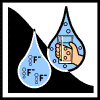1 -
Three Stages in Human Evolution
2 - Stone Age Humans
3 - Greece
& Rome
4 - The
17th and 18th Centuries
5 - The Social Reforms
of the 19th and 20 Centuries
6 - 1950
to 2000 - The Coming Gerontocracy
7 - The
Problem
8 -The
Solution
|
Philosophical changes which occurred
during the Enlightenment or Age of Reason of the 18th Century led to radical
social reforms during the 19th Century and that set the platform for the
great improvements in human health which became manifest during the early
20th Century.
Ten Great Public Health Achievements
-- 1900-1999
Since 1900, the average life-span
of persons in the industrialized countries has lengthened by greater than
30 years, of which 25 years are attributable to advances in standard of
living and public health measures. Of the later, 10 of the most important
developments are listed below.
| Vaccinations |
 |
| Safer workplaces |
 |
| Safer and healthier foods |
 |
| Motor-vehicle safety |
 |
| Control of infectious diseases |
 |
| Decline in deaths from coronary heart disease
and stroke |
 |
| Family planning |
 |
| Recognition of tobacco use as a health hazard |
 |
| Healthier mothers and babies |
 |
| Fluoridation of drinking water |
 |
|
| Although the practice of medicine has
existed since ancient times and the medical profession has usually been
held in high esteem, it is important to realize that the practice of curative
or clinical medicine had virtually zero impact on the improvement of human
survival throughout all of history until about 1950 when antibiotics were
invented. This is a startling observation, given the common impression that
the improvements in our life-expectancy are due to medical progress. First,
the practice of professional medicine was not available to most of the population
until the mid-20th Century, so even if there had been effective treatments,
only a few people would have had access to them. But more fundamentally,
until recently, the medical procedures which were available were more likely
to hasten, rather than retard, death. Indeed, much of the effort during
the 20th Century was an attempt to professionalize medicine and suppress
gross medical quackery. Looking at the survival curves of 1900 to 1941,
there was a dramatic improvement in life-expectancy - increasing from 49
years in 1900 to 74 by 1950. This improvement can be attributed almost entirely
to the scientific and social philosophy of the Enlightenment of the 18th
and 19th Centuries. Improved standard of living, a sufficient and clean
food supply, social justice, public sanitation, vaccination, personal hygiene,
and other such public health measures were the main causes for this improvement,
with their impact being mostly on the increase of survival during infancy
and childhood. The result was that most people began living long enough
to age. |